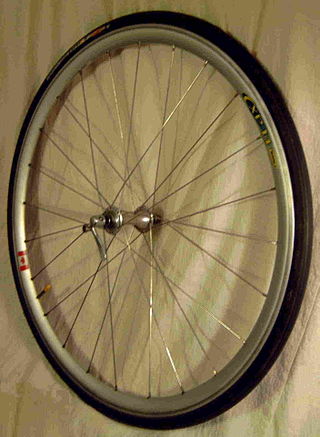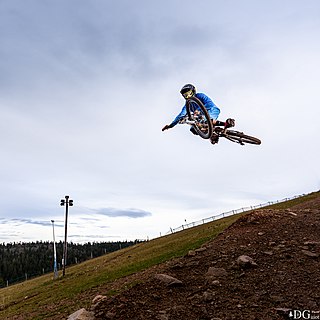
A bicycle, also called a pedal cycle, bike, push-bike or cycle, is a human-powered or motor-powered assisted, pedal-driven, single-track vehicle, having two wheels attached to a frame, one behind the other. A bicycle rider is called a cyclist, or bicyclist.

A mountain bike (MTB) or mountain bicycle is a bicycle designed for off-road cycling. Mountain bikes share some similarities with other bicycles, but incorporate features designed to enhance durability and performance in rough terrain, which makes them heavier, more complex and less efficient on smooth surfaces. These typically include a suspension fork, large knobby tires, more durable wheels, more powerful brakes, straight, extra wide handlebars to improve balance and comfort over rough terrain, and wide-ratio gearing optimised for topography and application. Rear suspension is ubiquitous in heavier-duty bikes and now common even in lighter bikes. Dropper posts can be installed to allow the rider to quickly adjust the seat height.

Mountain biking is a sport of riding bicycles off-road, often over rough terrain, usually using specially designed mountain bikes. Mountain bikes share similarities with other bikes but incorporate features designed to enhance durability and performance in rough terrain, such as air or coil-sprung shocks used as suspension, larger and wider wheels and tires, stronger frame materials, and mechanically or hydraulically actuated disc brakes. Mountain biking can generally be broken down into five distinct categories: cross country, trail riding, all mountain, downhill, and freeride.

A bicycle frame is the main component of a bicycle, onto which wheels and other components are fitted. The modern and most common frame design for an upright bicycle is based on the safety bicycle, and consists of two triangles: a main triangle and a paired rear triangle. This is known as the diamond frame. Frames are required to be strong, stiff and light, which they do by combining different materials and shapes.

A bicycle wheel is a wheel, most commonly a wire wheel, designed for a bicycle. A pair is often called a wheelset, especially in the context of ready built "off the shelf" performance-oriented wheels.
The Cannondale Bicycle Corporation is an American division of Dutch conglomerate Pon Holdings that supplies bicycles. Its headquarters are in Wilton, Connecticut, with engineering offices in Freiburg, Germany. Frames are manufactured in Taiwan.

A touring bicycle is a bicycle designed or modified to handle bicycle touring. To make the bikes sufficiently robust, comfortable and capable of carrying heavy loads, special features may include a long wheelbase, frame materials that favor flexibility over rigidity, heavy duty wheels, and multiple mounting points.

A utility bicycle,city bicycle, urban bicycle, European city bike (ECB), Dutch bike, classic bike or simply city-bike, is a bicycle designed for frequent very short, very slow rides through very flat urban areas. It is a form of utility bicycle commonly seen around the world, built to facilitate everyday short-distance riding in normal clothes in cold-to-mild weather conditions. It is therefore a bicycle designed for very short-range practical transportation, as opposed to those primarily for recreation and competition, such as touring bicycles, racing bicycles, and mountain bicycles. Utility bicycles are the most common form globally, and comprise the vast majority found in the developing world. City bikes may be individually owned or operated as part of a public bike sharing scheme.

A racing bicycle, also known as a road bike is a bicycle designed for competitive road cycling, a sport governed by and according to the rules of the Union Cycliste Internationale (UCI).
Hybrid bicycles blend characteristics from more specialized road bikes, touring bikes and mountain bikes. The resulting "hybrid" is a general-purpose bike that can tolerate a wide range of riding conditions and applications. Their stability, comfort and ease of use make them popular with novice cyclists, casual riders, commuters, and children.

A bicycle fork is the part of a bicycle that holds the front wheel.

Freeride is a discipline of mountain biking closely related to downhill biking, dirt jumping, freestyle motocross, and freestyle BMX. When riding a freerider one focuses on tricks, style, and technical trail features. Freeride is now recognized as one of the most popular disciplines within mountain biking.

Dirt jumping is the practice of riding bikes over jumps made of dirt or soil and becoming airborne. Dirt Jumping evolved alongside BMX racing and is similar to BMX or mountain bike racing in that the rider jumps off of mounds of dirt, usually performing a midair trick in between. It differs in that the jumps are usually much larger and designed to lift the rider higher into the air. Additionally, the goal is not to complete the course with the fastest time, but rather to perform the tricks with the style. Dirt jumping can be performed on BMX bikes or specialized mountain bikes known simply as "dirt jumpers".

Bicycle suspension is the system, or systems, used to suspend the rider and bicycle in order to insulate them from the roughness of the terrain. Bicycle suspension is used primarily on mountain bikes, but is also common on hybrid bicycles.

Cross-country (XC) cycling is a discipline of mountain biking. Cross-country cycling became an Olympic sport in 1996 and is the only form of mountain biking practiced at the Olympics.

The stem is the component on a bicycle that connects the handlebars to the steerer tube of the bicycle fork. Sometimes called a goose neck, a stem's design belongs to either a quill or threadless system, and each system is compatible with respective headset and fork designs:
Motorcycle components and systems for a motorcycle are engineered, manufactured, and assembled in order to produce motorcycle models with the desired performance, aesthetics, and cost. The key components of modern motorcycles are presented below.

Mountain bike trials, also known as observed trials, is a discipline of mountain biking in which the rider attempts to pass through an obstacle course without setting foot to ground. Derived from motorcycle trials, it originated in Catalonia, Spain as trialsín and is said to have been invented by Pere Pi, the father of Ot Pi, a world champion motorcycle trials rider. Pi's father had wanted his son to learn motorcycle trials by practicing on an ordinary bicycle.















